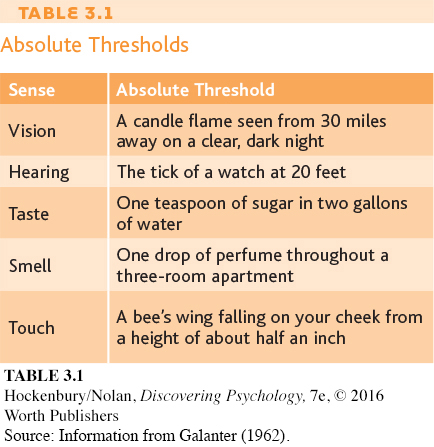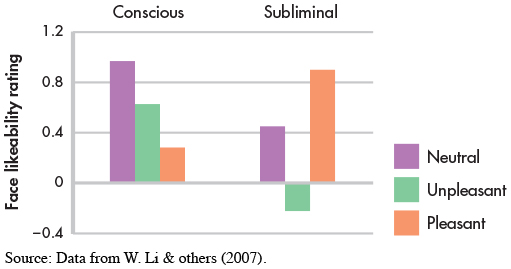INTRODUCTION:
What Are Sensation and Perception?
Glance around you. Notice the incredible variety of colors, shades, shadows, and images. Listen carefully to the diversity of sounds, loud and soft, near and far. Focus on everything that’s touching you—
With these simple observations, you have exercised four of your senses: vision, hearing, touch, and smell. As we saw in Chapter 2, the primary function of the nervous system is communication—

In this chapter, we will explore the overlapping processes of sensation and perception. Sensation refers to the detection and basic sensory experience of environmental stimuli, such as sounds, images, and odors. Perception occurs when we integrate, organize, and interpret sensory information in a way that is meaningful. Here’s a simple example to contrast the two terms. Your eyes’ physical response to light, splotches of color, and lines reflects sensation. Integrating and organizing those sensations so that you interpret the light, splotches of color, and lines as a painting, a flag, or some other object reflects perception. Mike’s visual world reflects this distinction. Although his eye was accurately transmitting visual information from his environment (sensation), his brain was unable to make sense out of the information (perception).
Where does the process of sensation leave off and the process of perception begin? There is no clear boundary line between the two processes as we actually experience them. In fact, many researchers in this area of psychology regard sensation and perception as a single process.
Although the two processes overlap, we will present sensation and perception as separate discussions. In the first half of the chapter, we’ll discuss the basics of sensation—
Basic Principles of Sensation
KEY THEME
Sensation is the result of neural impulses transmitted to the brain from sensory receptors that have been stimulated by physical energy from the external environment.
KEY QUESTIONS
What is the process of transduction?
What is a sensory threshold, and what are two main types of sensory thresholds?
How do sensory adaptation and Weber’s law demonstrate that sensation is relative rather than absolute?
We’re accustomed to thinking of the senses as being quite different from one another. However, all our senses involve some common processes. All sensation is a result of the stimulation of specialized cells, called sensory receptors, by some form of energy.
Imagine biting into a juicy strawberry. Your experience of hearing the strawberry crunch is a response to the physical energy of vibrations in the air, or sound waves. The sweet, slightly tart taste of the strawberry is a response to the physical energy of dissolvable chemicals in your mouth, just as the distinctive sharp aroma of the strawberry is a response to airborne chemical molecules that you inhale through your nose. The prickly feel of the strawberry’s skin is a response to the pressure of the strawberry against your hand. And the bright red color of the strawberry is a response to the physical energy of light waves reflecting from the irregularly shaped sphere.
Sensory receptors convert these different forms of physical energy into electrical impulses that are transmitted via neurons to the brain. The process by which a form of physical energy is converted into a coded neural signal that can be processed by the nervous system is called transduction. These neural signals are sent to the brain, where the perceptual processes of organizing and interpreting the coded messages occur. Figure 3.1 illustrates the basic steps involved in sensation and perception.

We are constantly being bombarded by many different forms of energy. For instance, at this very moment radio and television waves are bouncing around the atmosphere and passing through your body. However, sensory receptors are so highly specialized that they are sensitive only to very specific types of energy (which is lucky, or you might be seeing Friends reruns in your brain right now). So, for any type of stimulation to be sensed, the stimulus energy must first be in a form that can be detected by our sensory receptor cells. Otherwise, transduction cannot occur.
SENSORY THRESHOLDS
Along with being specialized as to the types of energy that can be detected, our senses are specialized in other ways as well. We do not have an infinite capacity to detect all levels of energy. To be sensed, a stimulus must first be strong enough to be detected—
The absolute threshold refers to the smallest possible strength of a stimulus that can be detected half the time. Why just half the time? It turns out that the minimum level of stimulation that can be detected varies from person to person and from trial to trial. Because of this human variability, researchers have arbitrarily set the limit as the minimum level of stimulation that can be detected half the time. Under ideal conditions (which rarely occur in normal daily life), our sensory abilities are far more sensitive than you might think (see Table 3.1). Can stimuli that are below the absolute threshold affect us? We discuss this question in the Science Versus Pseudoscience box, “Subliminal Perception.”

The other important threshold involves detecting the difference between two stimuli. The difference threshold is the smallest possible difference between two stimuli that can be detected half the time. Another term for the difference threshold is just noticeable difference, which is abbreviated jnd.
The just noticeable difference will vary depending on its relation to the original stimulus. This principle of sensation is called Weber’s law, after the German physiologist Ernst Weber (1795–
What Weber’s law underscores is that our psychological experience of sensation is relative. That is, there is no simple, one-
SENSORY ADAPTATION
Suppose your best friend has invited you over for a spaghetti dinner. As you walk in the front door, you’re almost overwhelmed by the odor of onions and garlic cooking on the stove. However, after just a few moments, you no longer notice the smell. Why? Because your sensory receptor cells become less responsive to a constant stimulus. This gradual decline in sensitivity to a constant stimulus is called sensory adaptation. Once again, we see that our experience of sensation is relative—
Because of sensory adaptation, we become accustomed to constant stimuli, which allows us to quickly notice new or changing stimuli. This makes sense. If we were continually aware of all incoming stimuli, we’d be so overwhelmed with sensory information that we wouldn’t be able to focus our attention. So, for example, once you manage to land your posterior on the sofa, you don’t need to be constantly reminded that the sofa is beneath you.

SCIENCE VERSUS PSEUDOSCIENCE
Subliminal Perception
What are subliminal messages? Can they influence people to quit smoking, lose weight, or change their personalities? Subliminal perception refers to the detection of stimuli that are below the threshold of conscious perception or awareness. Such stimuli might be rapidly flashed visual images, sounds, or odors that are too faint to be consciously detected. Although not consciously perceived, subliminal stimuli can evoke a brain response (Bahrami & others, 2007; Tamietto & de Gelder, 2010).
The notion that people’s behavior could be manipulated by subliminal messages first attracted public attention in 1957. James Vicary, a marketing executive, claimed to have increased concession sales at a New Jersey movie theater by subliminally flashing the words “Eat popcorn” and “Drink Coke” during the movie.
Controlled tests, however, failed to replicate Vicary’s claims, and Vicary later admitted that his boast was a hoax to drum up customers for his failing marketing business (Dijksterhuis & others, 2005; Fullerton, 2010). Nevertheless, to this day, many people still believe—
Can your behavior be profoundly influenced by subliminal self-
MYTH SCIENCE
Is it true that subliminal messages can produce lasting changes in your attitudes and behavior?
But do subliminal stimuli have any effect? Surprisingly, the answer is a qualified yes. For example, consider the mere exposure effect, which refers to the well-
Subliminal stimuli can influence actual behavior—

Beyond preferences, attitudes and emotions can also be influenced by subliminal stimuli (Smith & others, 2008; Westen & others, 2007). For example, participants were subliminally exposed to faces expressing fear, disgust, or a neutral emotion before being asked to rate the pleasantness of other faces presented on a computer screen. Faces that were preceded by subliminal “fear” stimuli were rated as most unpleasant (Lee & others, 2011).
Can other sensory cues affect us without our awareness? One intriguing study investigated the effect of subliminal odors (W. Li & others, 2007). Participants rated pictures of faces for “likeability” after sniffing either a pleasant, lemony scent; an unpleasant scent (think high school locker room); a neutral scent; or no scent at all (air). The catch was that 75% of the time, the odors were so faint that they could not be consciously detected. Did the subliminal odors affect the likeability ratings?
Yes–
Why? According to lead researcher Wen Li (W. Li & others, 2007), “People who were conscious of the barely noticeable scents were able to discount that sensory information and just evaluate the faces.” But participants who were not conscious of the odors attributed their response to the “pleasantness” or “unpleasantness” of the faces they were rating, rather than to the smells that they could not consciously perceive.
What can be concluded? Subliminal stimuli can briefly influence attitudes, thoughts, preferences, and emotions (Dijksterhuis & Nordgren, 2006). But the key word here is briefly. These transient influences are a far cry from the pseudoscientific claims of some subliminal self-